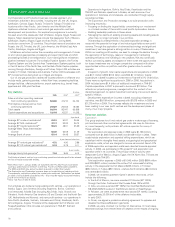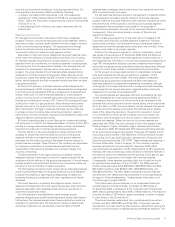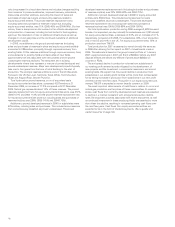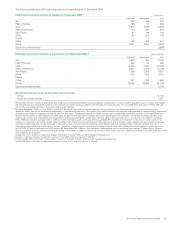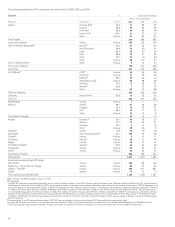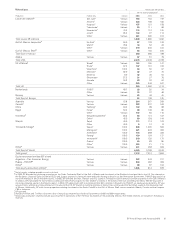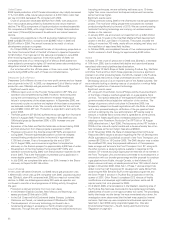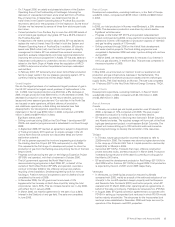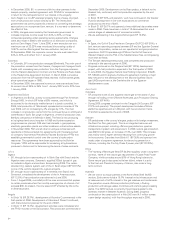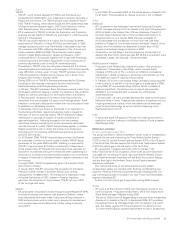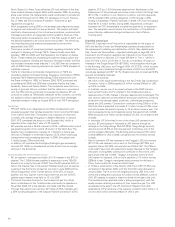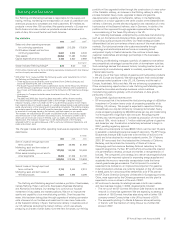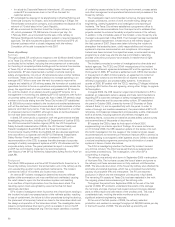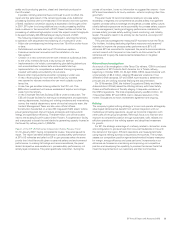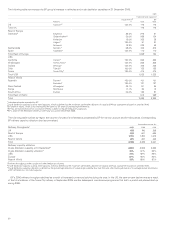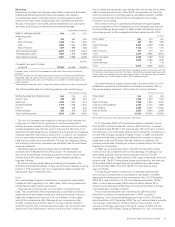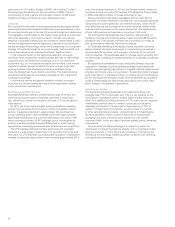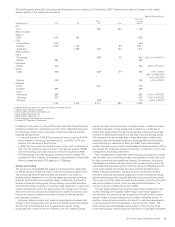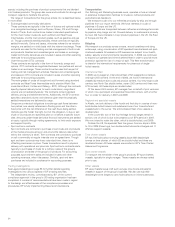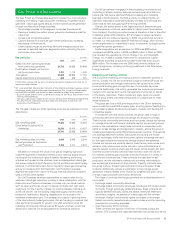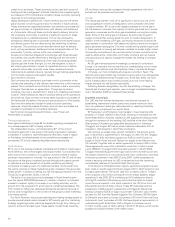BP 2006 Annual Report Download - page 28
Download and view the complete annual report
Please find page 28 of the 2006 BP annual report below. You can navigate through the pages in the report by either clicking on the pages listed below, or by using the keyword search tool below to find specific information within the annual report.North Slope oil to West Coast refineries. BP took delivery of the first
three tankers between August 2004 and November 2005. As existing
ships were retired, the replacements were constructed in accordance
with the Oil Pollution Act of 1990. For discussion of the Oil Pollution
Act of 1990, see Environmental Protection – Maritime oil spill
regulations on page 44.
– Work progressed during 2006 on the strategic reconfiguration project
to upgrade and automate four pump stations. This project will install
electrically driven pumps at four critical pump stations, combined with
increased automation and upgraded control systems. Start-up of the
first pump station is expected to occur in the first quarter of 2007, with
thesecondexpectedtobeonlinebytheendof2007.Theremaining
two reconfigured pump stations are expected to come online
sequentially after 2007.
– There are a number of unresolved protests regarding intrastate tariffs
charged for shipping oil through TAPS. These protests were filed
between 1986 and 2003 with the Regulatory Commission of Alaska
(RCA). These matters are proceeding through the Alaska judicial and
regulatory systems. Pending the resolution of these matters, the RCA
has imposed intrastate rates effective 1 July 2003 that are consistent
with its 2002 Order requiring refunds to be made to TAPS shippers of
intrastate crude oil.
– Tariffs for interstate and intrastate transportation on TAPS are
calculated utilizing the Federal Energy Regulatory Commission (FERC)
endorsed TAPS Settlement Methodology (TSM) entered into with
the State of Alaska in 1985. In February 2006, FERC combined and
consolidated all 2005 and 2006 rate complaints filed by the State,
Anadarko, Tesoro and Tesoro Alaska. The complaints were filed on a
variety of grounds. We are confident that the rates are in accordance
with the TSM and are continuing to evaluate the disputes. BP will
continue to collect its TSM-based interstate tariffs; however, our tariffs
are subject to refund depending on the outcome of the challenges.
Interstate transport makes up roughly 93% of total TAPS throughput.
North Sea
– FPS (BP 100%) is an integrated oil and NGLs transportation and
processing system that handles production from more than 50 fields
in the Central North Sea. The system has a capacity of more than
1mmb/d, with average throughput in 2006 at 545mb/d. In January
2007, FPS completed the tying in of the Buzzard field, which is
expected to be a significant user of FPS capacity.
– BP operates and has a 29.5% interest in CATS, a 400-kilometre natural
gas pipeline system in the central UK sector of the North Sea. The
pipeline has a transportation capacity of 1.7bcf/d to a natural gas
terminal at Teesside in north-east England. CATS offers natural gas
transportation and processing services. In 2006, throughput was
1.1bcf/d (gross), 326mmcf/d (net).
– In addition, BP operates the Dimlington/Easington gas processing
terminal (BP 100%) on Humberside and the Sullom Voe oil and gas
terminal in the Shetlands.
Asia (including the former Soviet Union)
– BP, as operator, manages and holds a 30.1% interest in the BTC oil
pipeline. The 1,768-kilometre pipeline is expected to carry 750,000
barrels of oil a day by the end of 2007 from the BP-operated ACG oil
field in the Caspian Sea to the eastern Mediterranean port of Ceyhan.
Loading of the first tanker at Ceyhan occurred in June 2006 and the
official inauguration of the Turkish section of the BTC oil export
pipeline, the new Ceyhan marine export terminal and the full BTC
pipeline export system was held on 13 July 2006.
– The South Caucasus Pipeline for the transport of gas from Shah
Deniz in Azerbaijan to the Turkish border was ready for operation in
November 2006. BP is the operator and holds a 25.5% interest.
– Through the LukArco joint venture, BP holds a 5.75% interest (with
a 25% funding obligation) in the Caspian Pipeline Consortium (CPC)
pipeline. CPC is a 1,510-kilometre pipeline from Kazakhstan to the
Russian port of Novorossiysk and carries crude oil from the Tengiz field
(BP 2.3%). In addition to our interest in LukArco, we hold a separate
0.87% interest (3.5% funding obligation) in CPC through a 49%
holding in Kazakhstan Pipeline Ventures. In 2006, CPC total throughput
reached 31.2 million tonnes. During 2006, negotiations continued
between the CPC shareholders towards the approval of an expansion
plan. The expansion would require the construction of 10 additional
pump stations, additional storage facilities and a third offshore
mooring point.
Liquefied natural gas
Within BP, Exploration and Production is responsible for the supply of
LNG and the Gas, Power and Renewables business is responsible for
the subsequent marketing and distribution of LNG. (See details under
Gas, Power and Renewables – Liquefied natural gas on page 36).BP’s
Exploration and Production segment has interests in four major LNG
plants: the Atlantic LNG plant in Trinidad (BP 34% in Train 1, 42.5% in
each of Trains 2 and 3 and 37.8% in Train 4); in Indonesia, through our
interests in the Sanga-Sanga PSA (BP 38%), which supplies natural gas
to the Bontang LNG plant, and Tangguh (PSA, BP 37.2%), which is under
construction; and in Australia through our share of LNG from the NWS
natural gas development (BP 16.7% infrastructure and oil reserves/15.8%
gas and condensate reserves).
Assets and activities:
– We have a 10% equity shareholding in the Abu Dhabi Gas Liquefaction
Company, which in 2006 supplied 5.6 million tonnes (290bcf) of LNG,
up 3.6% on 2005.
– In Australia, we are one of six equal partners in the NWS Venture.
Each partner holds a 16.7% interest in the infrastructure and oil
reserves and a 15.8% interest in the gas reserves and condensate. The
joint venture operation covers offshore production platforms, a floating
production and storage vessel, trunklines, onshore gas processing
plants and LNG carriers. Construction continued during 2006 on a fifth
LNG train that is expected to process 4.7 million tonnes of LNG a year
and will increase the plant’s capacity to 16.6 million tonnes a year. The
train is expected to be commissioned during the second half of 2008.
NWS produced 12.0 million tonnes (544bcf) of LNG, an increase of 2%
on 2005.
– In Indonesia, BP is involved in two of the three LNG centres in the
country. BP participates in Indonesia’s LNG exports through its
holdings in the Sanga-Sanga PSA (BP 38%). Sanga-Sanga currently
delivers around 15.5% of the total gas feed to Bontang, one of the
world’s largest LNG plants. The Bontang plant produced 19.5 million
tonnes (886bcf) of LNG in 2006, compared with 19.4 million tonnes
in 2005.
– Also in Indonesia, BP has interests in the Tangguh LNG joint venture
(BP 37.2% and operator) and in each of the Wiriagar (BP 38% and
operator), Berau (BP 48% and operator) and Muturi (BP 1%) PSAs in
north-west Papua that are expected to supply feed gas to the Tangguh
LNG plant. During 2006, construction continued on two trains, with
start-up planned late in 2008. Tangguh is expected to be the third
LNG centre in Indonesia, with an initial capacity of 7.6 million tonnes
(388bcf) a year. Tangguh has signed sales contracts for delivery to
China, Korea and North America’s West Coast.
– In Trinidad, construction of the Atlantic LNG Train 4 (BP 37.8%) was
completed in December 2005, with the first LNG cargo delivered in
January 2006. Train 4 is now the largest producing LNG train in the
world and is designed to produce 5.2 million tonnes (253bcf) a year of
LNG. BP expects to supply at least two-thirds of the gas to the train.
The facilities will be operated under a tolling arrangement, with the
equity owners retaining ownership of their respective gas. The LNG
is expected to be sold in the US, Dominican Republic and other
destinations. BP’s net share of the capacity of Atlantic LNG Trains 1, 2,
3 and 4 is 6.5 million tonnes (305bcf) of LNG a year.
26


